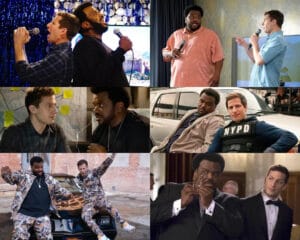This is part 6 of a series of posts publishing my Undergraduate dissertation titled An examination of superiority theory and power relations within the British sitcom Blackadder.
See the full series here.
In previous posts we identified several fundamental aspects of comedy theory, including definitions of superiority theory, the position of class and characterisation in Blackadder and the ideas of an object of ridicule and butt of the joke. We will now focus on the structure of situational comedy, including equilibrium and disequilibrium, and the importance of spatial awareness within a studio-filmed television show, which is how Blackadder II, Blackadder the Third and Blackadder Goes Forth were filmed. This will aid us in identifying how power relations and spatial awareness were so important to Blackadder Goes Forth.
There are several integral aspects of comedy which must work together closely for success, such as the form of comedy, the format for the series, setting and spatial relationships. Leo Charney (2005, p. 586) outlines the “highly ritualized form” of television sitcoms: “a half-hour time frame; a setting in a home and/or workplace; a set of four to eight recurring characters, each defined by fixed character traits that generate predictable reactions and ritualized conflicts; and three genres: family comedy, friends-as-family comedy, and workplace comedy.”
This typically occurs within an “adapted form of Todorov’s equilibrium-disequilibrium-new-equilibrium model of narrative – a movement, not towards a new equilibrium but rather to a forceful restatement of the existing equilibrium, a narrative status-quo-ante.” (Langford, 2005, p. 17, their emphasis). Blackadder challenges these narratives through conflict within a workplace comedy with a familial overtone, especially in Blackadder Goes Forth where the dugout is their home and workplace, and in Blackadder the Third where you never see Blackadder’s servant quarters – a concept I will return to later.

It isn’t particularly that these situations are unimaginable in everyday life, but rather the way in which they escalate out of control is unimaginable. Del Boy being mistaken for Mafia Boss Don Vincenzo Occhetti in Only Fools and Horses (Sullivan & Dow, 1991) is perfectly believable, but not the way in which he has no control over how it escalates; Howard rushing to develop a fix for his special toilet in place on the International Space Station in The Big Bang Theory (Lorre et al., 2009) is believable, but not the way in which his mother’s meatloaf is launched into the ceiling when they test the repairs; or Roy desperately trying to find a window-cleaner who left his ladders at his flat in The IT Crowd (Lineham, 2010) is believable, but the exaggeration of the fact and his complete lack of control over the situation is within the realms of unbelievability. However, the resolution of the problem at the end of the episode is inevitable, thus allowing a new story to be told in episodes to come.

Particularly, Blackadder’s group find themselves in situations which escalate based on loss of control and misunderstanding, but the concept of not being able to choose the people you work with remains the same. It could be argued that Blackadder could easily choose not to work with Baldrick, as in “Bells” he fires him to replace him with Bob, but when Baldrick offers to work for even less than the zero pennies he is currently paid, Blackadder finds himself unable to get rid of him.
- Charney, L. (2005). Television Sitcoms. In M. Charney (Ed.), Comedy: A Geographic and Historical Guide. (pp. 586-600). Connecticut: Greenwood Press.
- Eaton, M. (1981). Television Situation Comedy. In T. Bennett, S. Boyd-Bowman, C. Mercer & J. Woollacott (Eds). Popular Television and Film. (pp. 26-52). British Film Institute.
- Goor, D., Schur, M., Miner, D., Lord, P., Miller, C., Tredici, L. D., & Phillips, D. (Executive Producers). (2013-2021). Brooklyn Nine-Nine [TV series]. Fremulon; Dr. Goor Productions; 3 Arts Entertainment.
- Langford, B. (2005) ‘Our usual impasse’: the episodic situation comedy revisited. In J. Bignell & S. Lacey (Eds). Popular television drama. (pp. 15-33). Manchester University Press.
- Linehan, G. (Writer & Director). (2010, July 2). The Final Countdown (Series 4, Episode 2) [Television series episode]. In A. Atalla (Executive Producer). The IT Crowd. Talkback Thames; Channel 4 Television Corporation.
- Lorre, C., Prady, B., Aronsohn, L., Molaro, S., Kaplan, E., Ferrari, M., Goetsche, D., & Holland, S. (Executive Producers). (2007-2019). The Big Bang Theory [TV series]. Chuck Lorre Productions; Warner Bros. Television.
- Lorre, C., Prady, B., Molaro, S. (Writers), & Cendrowski, M. (Director). (2009, June 16). The Classified Materials Turbulence (Series 2, Episode 22) [TV series episode]. In Lorre, C., Prady, B., Aronsohn, L., Molaro, S., Kaplan, E., Ferrari, M., Goetsche, D., & Holland, S. (Executive Producers). The Big Bang Theory. Chuck Lorre Productions; Warner Bros. Television.
- [Stephen Wagg’s Because I Tell a Joke or Two]. (n.d.). Retrieved 12 May 2025, from https://books.google.rw/books?id=5ut5ctv1BBsC
- Sullivan, J. (Writer), & Dow, T. (Director). (1991, December 25). Miami Twice (Series 7, Episode 8) [TV series episode]. In J. Sullivan (Executive Producer). Only Fools and Horses. British Broadcasting Corporation (BBC).
- sunny4dayz93. [username]. (2022, September 17). There needs to be a spin-off of Jake Peralta and Doug Judy. Would you watch?! [Online forum post]. Reddit. https://www.reddit.com/r/brooklynninenine/comments/xg7mji/there_needs_to_be_a_spinoff_of_jake_peralta_and
- Wagg, S. (1998). ‘AT EASE CORPORAL’ Social class and the situation comedy in British television, from the 1950s to the 1990s. In S. Wagg (Ed.), Because I tell a Joke or Two. (pp. 1-31). Routledge.
APA7
Cable, J. (2025, May 16). The structure of situational comedy. JCableMedia.com. [permalink].
Chicago
Cable, John. “The structure of situational comedy.” JCableMedia.com. May 16, 2025. [permalink].
Harvard
Cable, J. (2025). The structure of situational comedy. Available at: [permalink] (Accessed: 30 November 2025).